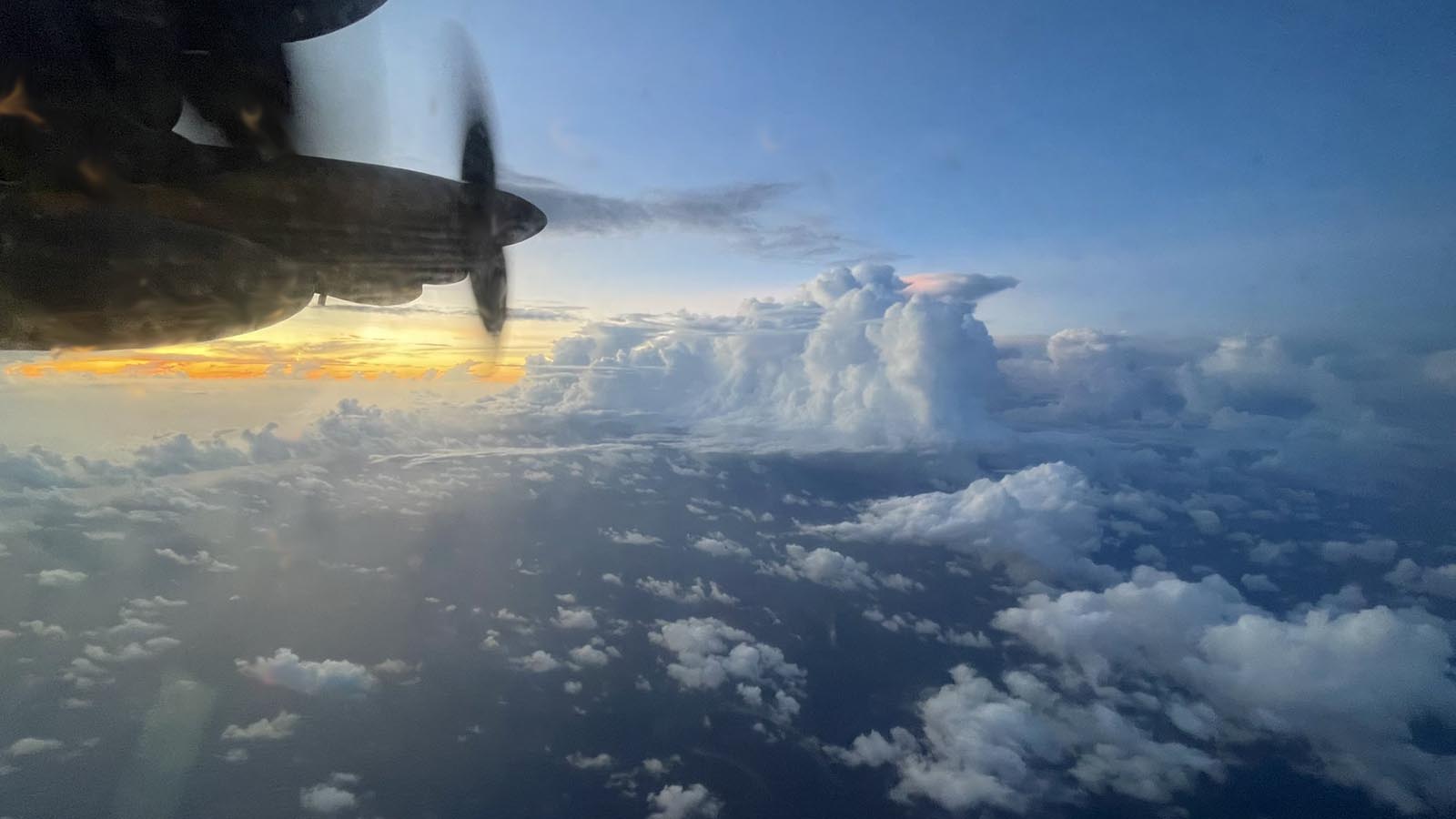
The reason: Outflow from powerful Hurricane Fiona was bringing strong northeasterly winds over TD 9, creating about 20-25 knots of wind shear.
Continued high wind shear from Fiona’s upper-level outflow is expected to impede development of TD 9 through Saturday morning, and its close proximity to the coast of South America may also hinder it.Odds for development will rise by Saturday afternoon, when Fiona will be approaching Canada, allowing wind shear over TD 9 to drop to the moderate range, 10-20 knots.
Highly favorable conditions for development are expected by Saturday night, when TD 9 will be in the central Caribbean: There, it will find very warm water of 30-31 degrees Celsius (86-88°F) with a high heat content, light wind shear, excellent outflow channels aloft, and a moist atmosphere (a mid-level relative humidity of 70%).
Beginning on Sunday morning, when TD 9 will be south of Jamaica, NHC predicted TD 9 to go from a tropical storm with 50 mph winds to a category 1 hurricane with 85 mph winds in 24 hours.
In addition, TD 9 may be hampered at that time by an increase in wind shear, as an upper-level low to the west of Cuba brings a southerly flow of upper-level winds over the storm.
NHC currently has TD 9 topping out as a category 3 hurricane with 115 mph winds on Wednesday morning near the coast of southwestern Florida, but this forecast should be regarded as highly uncertain.It would not be a surprise if TD 9 rapidly intensified at a greater rate than NHC is predicting: The western Caribbean is a notorious breeding ground for major hurricanes, and the top intensity model for making 4- and 5-day forecasts for Hurricane Fiona, the HWRF model, was predicting that TD 9 would reach category 4 strength in six days, as was the top intensity model from 2021, the HMON (Figure 2).Winds of tropical storm force could arrive in southern FL by Tue am, so hurricane watch could go up by Sun am.These can occur because of relatively subtle changes in the steering flow, and from center reformations when wind shear rips into the core of TD 9.
By Saturday, when TD 9 should have a stronger circulation and be a tropical storm, we will have a much better idea where it is going.
#Fiona has reintensified to a Category 4 #hurricane with max winds of 130 mph – the highest latitude Atlantic Category 4 hurricane since Debby (1982).One of the strongest storms in Canadian history is expected late Friday into Saturday, as category 4 Hurricane Fiona quickly transforms into a massive and powerful post-tropical cyclone just hours before landfall. Rare hurricane and tropical storm warnings have been issued by Environment Canada across a span of roughly 800 miles, from eastern New Brunswick and far southeast Quebec to Nova Scotia and most of Newfoundland and Labrador.EDT Friday, Hurricane Fiona was charging northeast at 35 mph with top sustained winds of 130 mph, about 250 miles north of Bermuda, according to the National Hurricane Center (NHC).
As Fiona accelerates northward over unusually warm midlatitude waters, it is expected to remain a potent hurricane into Friday evening, perhaps maintaining category 3 strength.
Much like Hurricane Sandy’s transition to “superstorm” just before it struck New Jersey in October 2012, the approaching midlatitude storm will envelop Fiona and quickly become a vast post-tropical storm system, but with the hurricane’s warm core still tucked within (secluded).
Multiple models are predicting Fiona to reach Nova Scotia on Saturday morning with a central pressure around or below 930 mb, which would easily break the all-time record in Canada for sea-level pressure of 940.2 mb set at St.
However, in this case of Fiona, the pressure differential across the storm – which drives the surface winds – will be dispersed over a much broader region, so winds of tropical-storm and even hurricane strength will cover a vast area.
Monitoring the intricacies of the seemingly inevitable sting jet development (as #Fiona transitions to an extratropical cyclone over Nova Scotia) will be an important part of the mesoscale forecast for potentially significant wind gusts with this system.Friday, NHC was predicting Fiona will reach the coast of eastern Nova Scotia on Saturday morning as a post-tropical cyclone packing top sustained winds just east of its center of 100 mph.
These values suggest an exceptionally large storm by both tropical and extratropical standards, not far below what Hurricane Sandy of 2012 brought (see Tweet below).
Hurricane Juan, the costliest in Canadian history, made landfall near Halifax, Nova Scotia, at category 2 strength in 2003 with 100-mph sustained winds, wreaking some $200 million (USD 2003) in damage.Fiona is expected to strike a less populated area, with central winds that could be slightly less intense than Juan’s, but it is a much larger storm than Juan.
Tropical Storm Gaston was bringing gusty winds and heavy rains on Friday to the Azores Islands, where 2 – 6 inches of rain are expected from the stormGiven an array of less-than-ideal conditions, Gaston will probably weaken, as it enters a region with higher wind shear and colder waters
A tropical wave that moved off the west coast of Africa on Friday became Tropical Depression Ten (TD 10) at 11 a.mTucked in an area with light wind shear of only around 10 knots into Friday night, TD 10 will benefit from a moist mid-level atmosphere (relative humidity of 70 percent) and warm SSTs of around 27 degrees Celsius (81°F)NHC predicts TD 10 to become a minimal tropical storm by Saturday morning, before quickly increasing wind shear, cooler ocean temperatures, and drier air destroy the system by Sunday
